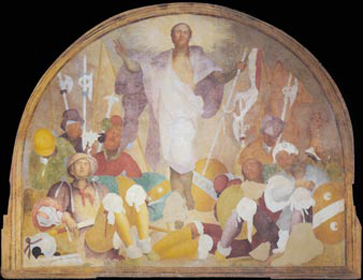Comparing the various periods of art, there has been an evolution in sculpture towards a more animated approach. Starting with the High Renaissance, we look at Michelangelo's earliest Pieta:

This masterpiece is the epitome of ideal beauty. Mary, looking gorgeous, seems as old as Jesus even though she's supposed to be his aging mother. There is an overall monumentality to this peice even though in reality it's quite small. Michelangelo enlarged her lap and scaled down Jesus to give it a nice balance, improving it from previous Pieta attempts.
Largely due to Michelangelo, sculpture also moved towards Mannerism, as seen with his later Pietas.

Everything is a bit off-balance, rougher, less ideal figures. As you can see, Jesus' body seems to be elongated and his legs malnourished. The subject matter is also less clear - who is the top figure? It's possibly Nicodemus or Michelangelo himself. For the most part, these two sculptures are to be viewed from the front exclusively. Later in the 2nd phase of mannerism called maniera, this began to change.
Giambologna, named the 2nd Michelangelo, was a star sculptor in Florence. The Rape of the Sabine Woman is a prime example of his work.

As you can see, this is a big step from the High Renaissance and very pre-Baroque. The serpentine composition with the many twisting nude figures shows his tremendous skill and desire to one up Michelangelo. Also, this sculpture is meant to be seen in all angles and sides. Their faces show great emotion making viewers feel that they are part of the frozen moment. Additionally, as with most mannerism peices, a tribute to art for art's sake is seen. All the male nudes with the "squeezed buttock effect", as my teacher describes it. The subject matter is more dramatic and serious but sculpted with such beauty.
Lastly, we enter the Baroque era where Bernini dominates with his graceful sculptures, mainly in Rome. Here's his version of the David, in response to Michelangelo's:

Especially with these three snapshots, it's almost like he's moving. Imagine walking around it, it seems like you're taken through his swing, frame by frame. Even though David looks strong, there's a weighless feeling in Bernini's technique, as with his other masterpeices -
Pluto and Persephone and
Apollo and Daphne. It's as though his sculptures are not made of marble or stone. When you see this sculpture, you're immediately response would be to duck otherwise you'll be hit by his sling. In baroque art, frozen moments are extremely real and in-action, less balanced, figures facial features are less ideal, more characterized - much like animation. Here, Bernini put a self-portrait, lip pursed. He pushed sculpture to the limits, transcending it's medium.
It's no wonder sculpture usually accompanies a character animator's cubicle!







